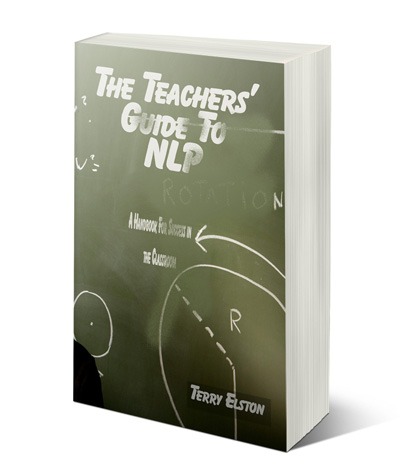Teachers Guide to NLP book
I wanted to write a book that teachers, lecturers or trainers could relate to.
Most books I had read about NLP has been either boring or too complicated for everyday people to understand. And i wanted to add a little colour to the classroom.
Here’s an excerpt from Chapter Five:
How we make sense of our worlds internally
V: Visual
People who are visual often stand or sit with their heads and/or bodies erect, with their eyes up towards the ceiling. They will be breathing from the top of their lungs. They often sit very upright in their chair and tend to talk very quickly. They memorize by seeing pictures, and are less distracted by noise. Appearances are important to them. A visual person will be interested in how your lesson/program LOOKS.

People who are auditory will move their eyes sideways. They breathe from the middle of their chest. They typically talk to themselves, and are easily distracted by noise, They will tend to spell phonetically. They prefer to learn something by hearing it. and usually like music and talking on the phone. The auditory person likes to be TOLD how they’re doing, and responds to a certain tone of voice. They will be interested in what you have to SAY about your program or how it SOUNDS to them.

People who are kinaesthetic will typically be breathing from the bottom of their lungs. They often move and talk verrry slooowly. They respond to physical rewards, and touching. They also may stand/sit closer to people than a visual person. They memorize by doing or walking through something. They will be interested in your program if it FEELS RIGHT.

I’m going to outline Ai in a lot more depth than the others as I know it’s a harder notion to understand than the rest. Firstly, let’s start by outlining the different names this function has. Self-talk can be classified as Ai (auditory internal), AD (auditory digital), unclassified, the labelling system or simply the voice in your head. Phew glad we’ve got that understood. So, when you see all the names it has, just know it’s that little voice that everyone has in their head that comments on everything!
As it’s not a direct part of the hard wiring, I tend to work with it as a dissociated part of the representational system. That’s not to say it’s any less important to making changes within a learning system. In business, for instance, the labelling system is used more than any other representational system.
The Ai (or Ad) person will spend a fair amount of time talking to themselves. They will want to know if your program MAKES SENSE; is it logical, does it follow a structure etc? This auditory digital person can exhibit characteristics of the other major representational systems.
If you imagine being in the police force, with all the horrors you may encounter, you need to label fact as opposed to what you feel. Having AD as a primary representational system may be a very good idea. That way you don’t have to experience the intensity through the other senses.
Self-talk is the habitual chatter that occupies your mind daily. If you are not too sure what I mean by that, just stop what you are doing and listen in: You have your own personal radio show going on inside your head!
This journalist in your head informs you of many things, yet has no real connection to reality as is known in fact. It relates to the filter systems (delete, distort, generalise) we were talking about in the early chapters.
When we worked with the presupposition The Map is Not The Territory, you may also see that the self-talk is also a map, not reality!
This voice in your head comments on everything yet has no power if not connected to the senses. With practice, you can gain control of the voice and make it yours again.
One technique I use with clients is to make the voice into another accent or at least make it a higher or lower pitch to distinguish it. That way, you begin to notice what are your chosen comments and what is a powerless (yet covertly influential) journalist.
It’s a good thing to know that each individual likes their information in a certain way, whether they have good or bad experiences coupled with a certain VAKOG modality. Some students can happily sit and listen for a long time, while others love to look at pictures to get good information. For some, neither of these learning styles will work. For those, they would have to try it out, use it, physically touch the subject, or even dance it!
This is well known in the corporate world, whereby the salesperson (if they have been well trained), will find out which system is your favourite, and then sell to you in that way. If you were interested in a car for instance, and he/she finds out your favoured modality is tactile (kinaesthetic), they will get you to actually test drive the car!
Ideas for reflection
What have you learned about the different ways people represent their world? For instance, if a client tells you that they just can’t grasp the information or that they don’t feel good about a subject, what could you do for improved connection with them?
(A) If a person told you that they just can’t stomach mathematics for instance, what representational system will they be using?
(B) If someone told you that they can’t understand the idea of physical exercise and that they just don’t get the concept or structure of it, what system are they in?
The answers will be (A) K and (B) Ai.









